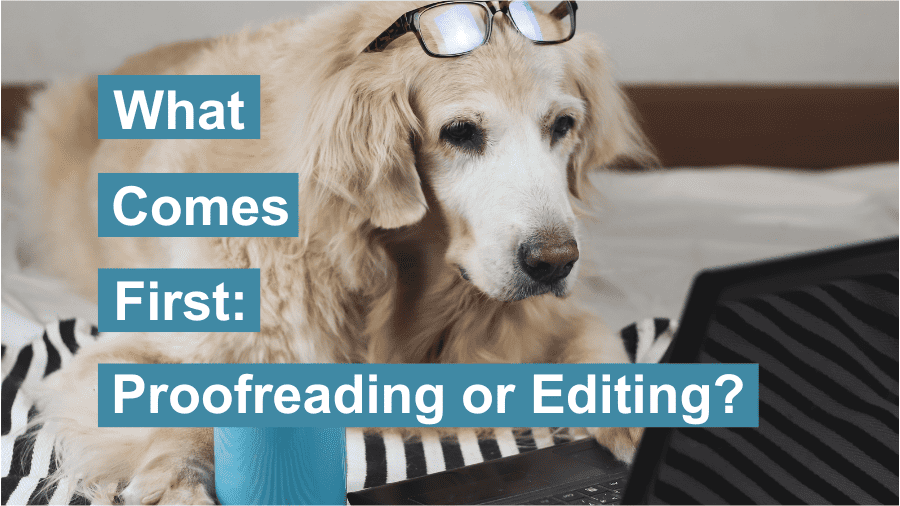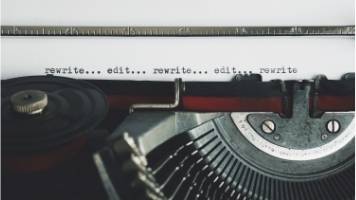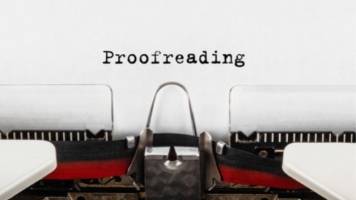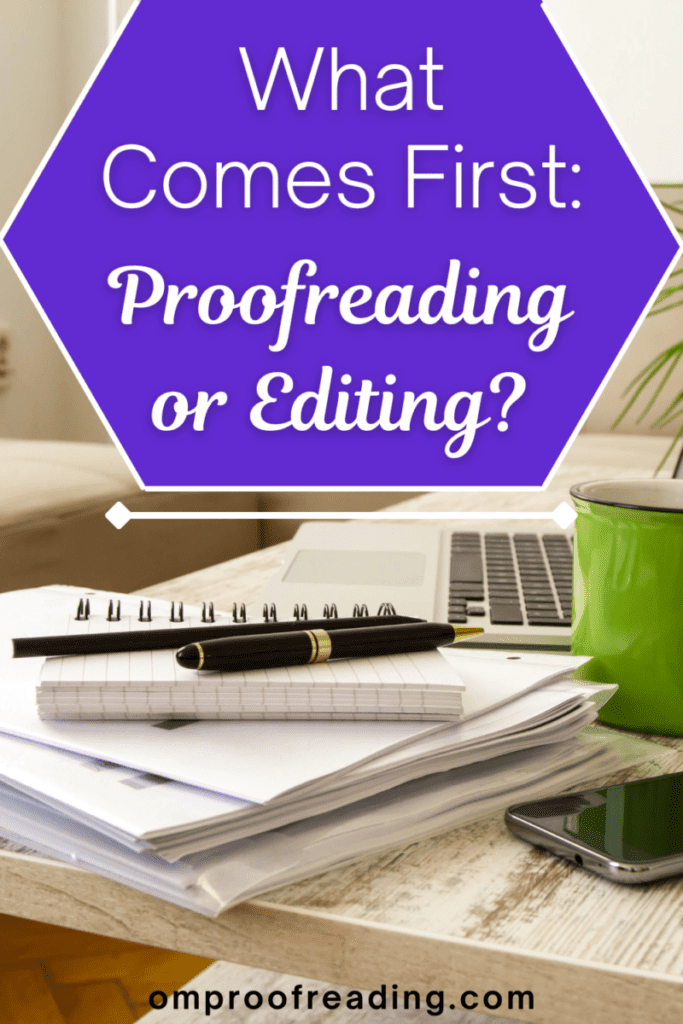This article may contain affiliate links. Please see our affiliate disclaimer in the footer menu for more information. Thank you for your support!

If you’re in the market for a proofreader or editor, you may wonder what comes first: proofreading or editing. As a trained proofreader, I can tell you how the editorial process works. By learning about the process, you can determine which editorial professional you need to hire and when you need to hire them.
Editing comes before proofreading. Developmental editing (aka substantive or structural editing) is the first stage in the editorial process. It focuses on the overall structure and content of a document. Proofreading is the last stage; it deals with minor details like grammar and punctuation.
Let’s discover more about proofreading, editing, and the editorial process. When you fully understand the role of the proofreader and editor, you’ll know what to expect when working with them, including the benefits you’ll get from each.
What Comes First: Proofreading or Editing?

As mentioned, editing comes before proofreading. Let’s look at the editing process to see how far apart editing and proofreading are. The editorial process consists of four stages:
- Developmental Editing (aka Structural Editing or Substantive Editing)
- Line Editing (aka Content Editing or Stylistic Editing)
- Copyediting
- Proofreading
When people say editing, they’re generally referring to developmental editing.
As we discover what occurs in these editing stages, you’ll notice how each step becomes more focused.
You can think of the editorial process as an inverted pyramid. At the base of the pyramid is the first editing stage: developmental editing.
Developmental editing examines the overall document, focusing on big-picture elements like text structure and flow.
As you move toward the pyramid’s peak, the scope of work becomes more focused.
At the peak of the pyramid is the last editing stage: proofreading.
Proofreading gets down to the nitty-gritty of a document. It looks at details like punctuation, grammar, and spelling.
What Is the Difference between Proofreading and Editing?
Let’s discover how proofreading and editing differ. We’ll also look at the two editing stages between developmental editing and proofreading.
Keep in mind that individual editors and proofreaders may vary a bit in the scope of their work and the use of terminology (e.g., developmental editing vs. structural editing vs. substantive editing).
Therefore, communication is vital to getting the editorial assistance you need.
As we go through the editing stages, you’ll see some overlap from one step to the next.
What Is Developmental Editing?

A developmental editor works on the document as a whole. Their responsibilities include the following:
- Improving the overall structure and content of the writing (includes reorganizing/adding/deleting large sections of text)
- Ensuring the writer has addressed all major points
- Making sure the writing makes sense overall
For works of fiction, a developmental editor looks at several other factors, including plot, pacing, character development, and setting.
Do You Need a Developmental Editor?
If you need help developing or organizing your content, you’d benefit from hiring a developmental editor.
They can help you discover what may be missing (e.g., holes in your argument or plot) and identify areas of your writing that need more explanation or clarification. They can also help you present ideas more effectively.
What Is Line Editing?
A line editor works on a text at the paragraph level and addresses major issues at the sentence level. Their job involves the following:
- Refining the language to improve clarity, flow, and consistency in tone and style
- Reorganizing sentences within paragraphs if needed
- Ensuring the level of language is suitable for the target audience
For fiction, a line editor ensures the dialogue is appropriate for the target audience and stays true to each character’s personality.
Do You Need a Line Editor?
If you need help maintaining consistency in tone and style and ensuring your language is fit for the intended audience, you’d benefit from a line editor.
They’re the ones who will take your language to the next level, improving the flow and readability of your document. They can assist you with rewording stilted sentences, showing vs. telling, changing passive voice to active voice, and more.
What Is Copyediting?
A copy editor works comprehensively at the sentence level on the following:
- Ensuring the writing is comprehensive, consistent, correct, clear, and concise
- Correcting errors with syntax (sentence structure)
- Fixing mistakes with grammar, capitalization, punctuation, spelling, and formatting
For fiction, a copy editor ensures consistency in the timeline and the characters’ physical features.
Do You Need a Copy Editor?
If you need someone to tighten up your writing and ensure each sentence is clear, a copy editor is your go-to professional.
A copy editor will use the appropriate style guide to ensure consistency throughout a document. They’ll also help you fix grammar gaffes and punctuation pitfalls lurking in your text.
What Is Proofreading?

A proofreader works comprehensively at the word level on the following:
- Correcting mistakes with grammar, capitalization, punctuation, spelling, and formatting
- Ensuring proper word choices (e.g., affect vs. effect)
- Checking for repeated or omitted words
The duties of a proofreader working for a publishing company differ from those of a typical freelance proofreader. Proofreaders at publishing companies work with typeset documents. They’re responsible for identifying problems with the text’s layout and ensuring the design specifications are followed.
Occasionally, they may even be required to use proofreading symbols. However, these continue to be less common as digital proofreading methods take over.
If you’d like more info about what proofreading typeset documents entails, here’s a brief video by Editors Canada.
Do You Need a Proofreader?
If you need a pair of eagle eyes to catch errors that were missed during previous editing stages, hire a proofreader.
They’ll use the appropriate style guide to eliminate remaining mistakes and make sure that no words have been misused, repeated, or omitted. Proofreaders put that final polish on your document to ensure it looks professional.
The importance of proofreading can’t be overstated.
I penned a post about how to find a reliable proofreader if you’d like some top-notch tips!
Why Should Editing Be Done before Proofreading?
Since editing typically involves restructuring, adding, and deleting text, it needs to be done prior to the detailed work of proofreading. Otherwise, the proofreader’s corrections may go to waste since the document will be significantly different after editing.
Imagine you’ve been working hard to create a piece of writing, and you’re finally finished. Whew! What sweet relief! You’ve overcome writer’s block and crafted your first draft. You know your grammar and punctuation aren’t up to par, so you hire a proofreader.
The proofreader works diligently to eradicate errors and polish your prose.
You thank them, pay them, and then sit down to read your polished document. You’re thankful that the proofreader corrected many mistakes you missed during the self-editing stage.
But wait. Looking back at your content with fresh eyes, you realize you haven’t sufficiently explained a couple of your main points. And what’s more, your content seems a bit unorganized. You want to make sure your writing is as coherent as possible.
You decide it would behoove you to hire an editor.
Your developmental editor works on your already proofread draft, and you’re surprised to see all the changes they’ve recommended when you get your document back.
They’ve reorganized your text, recommended that you explain a few points further, and suggested you rewrite a particular section to make it clearer. By the time you’ve finished your second draft, it looks significantly different from your first one—so much so that you need to hire a proofreader all over again to check everything you’ve rewritten.
Yikes! That’s an expense you hadn’t budgeted for!
Frequently Asked Questions

Does proofreading include editing?
Proofreading does not include editing. Editing involves shaping a document by improving its structure and content. Proofreading has a much narrower scope; it focuses on the details of a text, including grammar, capitalization, punctuation, spelling, and formatting.
Does editing include proofreading?
Editing does not include proofreading. An editor needs to focus on the big picture without getting bogged down by the details. Editors are the experts who consider a text’s overall content and organization; however, proofreaders are the professionals who deal with the details.
Nevertheless, some online editing and proofreading companies provide a combined editing and proofreading service they refer to as “editing.”
This editing service usually consists of developmental editing, proofreading, and everything in between.
When should proofreading be done?
Proofreading should be done after all the necessary editing has been completed. If proofreading is done before editing (especially developmental or line editing), it will probably be in vain since documents typically undergo significant changes during a developmental or line edit.
What comes before proofreading?
Three stages of editing come before proofreading: developmental editing, line editing, and copyediting. Proofreading is the fourth and final stage in the editing process. Additionally, for lengthy works, authors may use the services of alpha or beta readers prior to editing.
If you’d like to know what alpha and beta readers do, I cover that in my article “Proofreading vs. Beta Reading: Discover the Differences.”
Although it’s ideal for a document (especially long texts) to go through each editing stage, line editing and copyediting are sometimes combined into one service due to budgeting constraints.
Also, copyediting and proofreading may be the only services necessary for short documents that are structurally sound and easy to read.
Since proofreading and copyediting overlap to some degree, people often get confused about what these two editing stages involve. Therefore, I wrote a post called “Proofreading vs. Copyediting: What’s the Difference?”
Finally, we’ve answered the question of what comes before proofreading. But what comes before editing?
Revising is the stage in the writing process that comes before editing. If you’d like to learn more about revising, you can read my article “Proofreading vs. Revising: What’s the Difference?”
That concludes our discussion of whether editing or proofreading comes first.
Best wishes to you!
“The desire to reach for the stars is ambitious. The desire to reach hearts is wise.”
– Maya Angelou

Recent Posts
Punctuation is important because it enables us to communicate our message clearly and effectively. Without punctuation, we wouldn’t understand how units of a sentence relate to one another or how...
Although you're probably somewhat familiar with adverbs, you may be unaware of sentence adverbs. As a trained proofreader who has studied the parts of speech, I can help you understand this unique...
